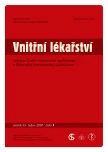The smoothness index of betaxolol hydrochloride in patients with newly diagnosed hypertension
Authors:
I. Řiháček; M. Souček; P. Fráňa
Authors‘ workplace:
II. interní klinika Lékařské fakulty MU a FN u sv. Anny, Brno, přednosta doc. MUDr. Miroslav Souček, CSc.
Published in:
Vnitř Lék 2007; 53(1): 25-30
Category:
Original Contributions
Overview
Introduction:
24-hour ambulatory blood pressure monitoring (ABPM) has a higher predictive value for cardiovascular diseases than occasional blood pressure (BP) measurement with sphygmomanometer. ABPM allows for the assessment of 24-hour effect of drugs administered once a day using the smoothness index (SI) method.
Objective of work:
Find out the 24-hour effect of betaxolol hydrochloride administered once a day by determining the smoothness index.
Cohort and methodology:
Examination of 30 newly diagnosed hypertonics prior to and after 3-month treatment with betaxolol hydrochloride at an average dose of 15 mg once a day. BP measurement using sphygmomanometer and ABPM (SpaceLabs 90207) according to European Society for Hypertension criteria. Determining the smoothness index from individual average hourly changes in BP after treatment by dividing the hourly values average by standard deviation. Calculation of average SI from individual patient data with standard deviation and 95 % confidence interval (95 % CI).
Result:
The calculated SI value of betaxolol hydrochloride was 1.03 ± 0.65 (95 % CI, 0.80 to 1.26) and 1.27 ± 0.89 (95 % CI, 0.95 to 1.59) for systolic and diastolic BP, respectively.
Conclusion:
Average SI of betaxolol hydrochloride is higher than 1 when both systolic and diastolic BP is measured. Based on the above parameter, the monitored drug has a sufficient 24-hour effect and can be administered once a day.
Key words:
beta-blockers – betaxolol hydrochloride – smoothness index tenze
Sources
1. Cífková R, Škodová Z, Lánská V et al. Decreased prevalence and improved control of hypertension in the Czech population. J Hypertens 2002; 20(Suppl 4): S326.
2. Chobanian AV, Bakris GL, Black HR et al. The Seventh Report of the Joint National Committee on Prevention, Detection, Evaluation, and Treatment of High Blood Pressure. THE JNC 7 Report. JAMA 2003; 289 : 2560-2572.
3. Guidelines Committee. 2003 European Society of Hypertension-European Society of Cardiology Guidelines for the Management of Arterial Hypertension. J Hypertens 2003; 21 : 1011-1053.
4. Cífková R, Horký K, Widimský J sr et al. Doporučení diagnostických a léčebných postupů u arteriální hypertenze - verze 2004. Doporučení České společnosti pro hypertenzi. Vnitř Lék 2004; 50 : 709-722.
5. Parati G, Omboni S, Rizzoni D et al. The smoothness index: a new, reproducible and clinically relevant measure of the homogeneity of the blood pressure reduction with treatment for hypertension. J Hypertens 1998; 16 : 1685-1691.
6. 41st World Medical Assembly. Declaration of Helsinki: recommendations guiding physicians in biomedical research involving human subjects. Bull Pan Am Health Organ 1990; 24 : 606-609.
7. Řiháček I. Dvouleté zkušenosti s 24hodinovým ambulantním monitorováním krevního tlaku, typy křivek u pacientů s čerstvě zjištěnou hypertenzí. Prakt Lék 1996; 76 : 392-394.
8. Sega R, Corrao G, Bombelli M et al. Blood pressure variability and organ damage in a general population. Results from the PAMELA study. Hypertension 2002; 39 : 710-714.
9. Pickering TG, James GD. Ambulatory blood pressure and prognosis. J Hypertens 1994; 12 (Suppl 8): S29-S34.
10. Mancia G, Frattola A, Groppeli A et al. Blood pressure reduction and end-organ damage in hypertension. J Hypertens 1994; 12 (Suppl 8): S35-S42.
11. Verdecchia P. Prognostic value of ambulatory blood pressure: Current evidence and clinical implications. Hypertension 2000; 35 : 844-852.
12. Division of Cardio-Renal Drug Products. Clin 05/09/88 proposed guidelines for the clinical evaluation of antihypertensive drugs-draft. 1-9. 1988. Food and Drug Library. ISH Health Information.
13. Soucek M, Rihacek I, Frana P A comparison of the trough/peak ratio of cardio-selective beta-blockers in patients with newly diagnosed hypertension. Blood Press Monit. 2006; 11(6):337-42.
14. Morgan T. 24hodinová kontrola krevního tlaku. Její význam, její hodnocení a používání poměru trough/peak. Praha: Servier 1998, 54 s.
15. Meredith PA. Trough/Peak Ratios for Antihypertensive Agents. Drugs 1994; 5 : 661-666.
16. Sierra A, Gil-Extremera B, Calvo C et al. Comparison of the antihypertensive effects of the fixed dose combination enalapril 10 mg/nitrendipine 20 mg vs losartan 50 mg/hydrochlorothiazide 12,5 mg, assessed by 24-h ambulatory blood pressure monitoring, in essential hypertensive patients. J Hum Hypertens 2004; 18 : 215-222.
Labels
Diabetology Endocrinology Internal medicineArticle was published in
Internal Medicine

2007 Issue 1
Most read in this issue
- The FEVER (Felodipine EVEnt Reduction) trial; a randomised, double-blind, placebo-controlled trial in Chinese hypertensive patients
- Guidelines for pharmacotherapy of acute and chronic non-oncological pain
- Epilepsy and disorders of reproduction
- The importance of determination of Nt-proBNP and big endothelin in diagnosing chronic heart failure in patients on regular haemodialysis treatment
